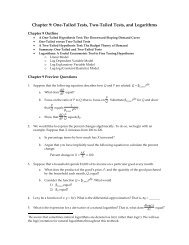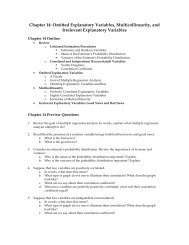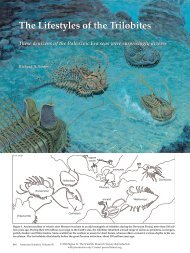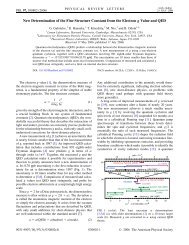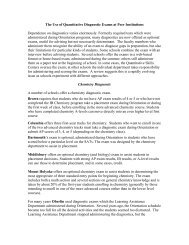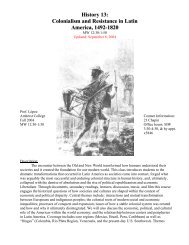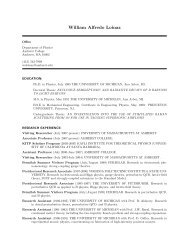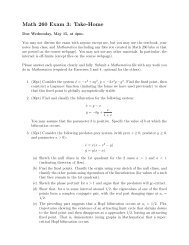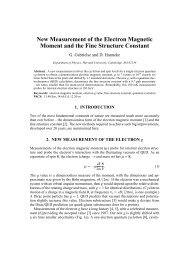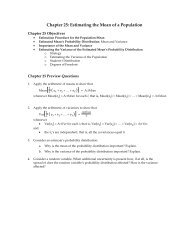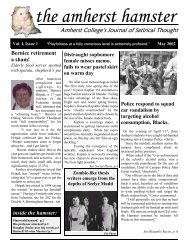sedimentary sedimentary - SEPM
sedimentary sedimentary - SEPM
sedimentary sedimentary - SEPM
Create successful ePaper yourself
Turn your PDF publications into a flip-book with our unique Google optimized e-Paper software.
Figure 2. PC-C boundary publications through<br />
time (constructed by searching GEOREF for<br />
‘Precambrian-Cambrian,’ ‘Proterozoic-<br />
Cambrian,’ and ‘Neoproterozoic-Cambrian’ in<br />
the title).<br />
known (e.g., Mongolia, Brasier et al., 1996;<br />
Olenik uplift, Siberia, Knoll et al., 1995;<br />
Mackenzie Mountains, northwestern<br />
Canada, Narbonne and Aitken, 1995;<br />
southern Great Basin, Corsetti and<br />
Hagadorn, 2000), not all of these contain<br />
the PC-C boundary. Also, not all the sections<br />
contain an appropriate juxtaposition<br />
of carbonate- and trace-fossil-rich siliciclastic<br />
strata. Thick, relatively complete, wellexposed,<br />
and easily accessible successions in<br />
the southern Great Basin contain siliciclastic<br />
units and the boundary-marking fossil, T.<br />
pedum, in association with carbonate units<br />
recording a complete δ 13 C chemostratigraphic<br />
profile (Corsetti and Kaufman,<br />
1994; Corsetti et al., 2000; Corsetti and<br />
Hagadorn, 2000; Hagadorn and Waggoner,<br />
2000). The southern Great Basin sections<br />
provide an excellent opportunity to compare<br />
results from a variety of stratigraphic<br />
approaches that have emerged as useful for<br />
correlating potential stage and series boundaries<br />
within the Cambrian (e.g., Geyer and<br />
Shergold, 2000).<br />
The Sedimentary Record<br />
Figure 3. A. Map showing distribution of four<br />
interfingering facies successions that span the<br />
PC-C interval in the southern Great Basin; successions<br />
become progressively thicker to the<br />
northwest, the offshore direction (after Nelson,<br />
1978; Corsetti et al., 2000; Fedo and Cooper,<br />
2001). B. Shaded area represents the approximate<br />
PC-C outcrop belt in the southern Great<br />
Basin (after Stewart, 1970); the Mt. Dunfee<br />
section was offset to its present position by post-<br />
Cambrian transtensional faulting.<br />
GEOLOGIC BACKGROUND<br />
From the time of Walcott (1908), the thick,<br />
superbly exposed, and highly fossiliferous<br />
Lower Cambrian strata from the southwestern<br />
United States (Figs. 3, 4, cover photo)<br />
have proved instrumental for understanding<br />
the Cambrian biotic explosion, and have<br />
even been suggested for a potential basal<br />
Cambrian stratotype (Cloud, 1973).<br />
Proterozoic—lower Paleozoic strata in the<br />
southern Great Basin were deposited on a<br />
thermally subsiding trailing margin created<br />
through rifting of the Laurentian craton in<br />
the Neoproterozoic (e.g., Stewart, 1966,<br />
1970; Stewart and Suczek, 1977; Armin<br />
and Mayer, 1983; Bond et al., 1985).<br />
Neoproterozoic-Cambrian strata in the<br />
southwestern United States thicken from<br />
southeast to northwest, and can be grouped<br />
into four distinct but interfingering successions:<br />
Craton, Craton Margin, Death Valley<br />
(proximal-shelf), and White-Inyo (proximal-<br />
to mid-shelf) successions (Stewart,<br />
1970; Nelson, 1976, 1978; Mount et al.,<br />
1991; Corsetti and Hagadorn, 2000; Fedo<br />
and Cooper, 2001; Fig. 3). An erosional disconformity<br />
removed the PC-C boundary<br />
interval in the Craton and Craton Margin<br />
successions (Fedo and Cooper, 1990, 2001).<br />
This sequence boundary is traceable from<br />
the Craton Margin through the Death<br />
Valley succession to the White Inyo succession,<br />
and probably represents the “Sauk I”<br />
disconformity (Palmer, 1981). The boundary<br />
interval resides below this unconformity<br />
where incision was limited. The Death<br />
Valley succession records both appropriate<br />
trace fossil biostratigraphy and carbon isotope<br />
data (Corsetti and Hagadorn, 2000).<br />
However, the sections are relatively thin and<br />
the carbonates from which the δ 13 C record<br />
was recovered are particularly thin. The<br />
White-Inyo succession is thickest, but, until<br />
now, has been considered poorly fossiliferous<br />
with respect to earliest Cambrian guide<br />
fossils (e.g., Signor and Mount, 1986).<br />
Trilobites, which are important guide fossils<br />
in Lower Cambrian sections in the Great<br />
Basin (e.g., Nelson, 1976; Palmer, 1981,<br />
1998; Hollingsworth, 1999), make their<br />
first appearance well above this interval<br />
(Hollingsworth, 1999).<br />
White-Inyo Succession<br />
In ascending order, the White-Inyo<br />
Succession consists of the Wyman<br />
Formation, Reed Dolomite, Deep Spring<br />
Formation, Campito Formation, Poleta<br />
Formation, Harkless Formation, and the<br />
Mule Spring Limestone (Nelson, 1962; Fig.<br />
4). The White-Inyo Mountains have been<br />
the focus of intense PC-C boundary study,<br />
but the paucity of earliest Cambrian fossils<br />
has been problematic (e.g., Cloud and<br />
Nelson, 1966; Taylor, 1966; Alpert, 1977;<br />
Figure 4. Generalized lithostratigraphic columns<br />
for the PC-C transition interval in the southern<br />
Great Basin (after Nelson, 1962, 1976; Stewart,<br />
1970; Fedo and Cooper, 2001). Whereas the<br />
Lower Cambrian portion is well constrained and<br />
correlated between the intervals, correlations<br />
between Neoproterozoic strata are less well constrained.<br />
Base of the Sauk I Sequence removes some<br />
of the Neoproterozoic-Lower Cambrian interval in<br />
more proximal (Craton Margin) settings. The<br />
Death Valley succession contains a Neoproterozoic<br />
glacial-cap-carbonate succession, but no known<br />
correlatives exist in the White-Inyo succession.<br />
Fossil symbols represent first occurrences of key taxa.<br />
May 2003 | 5




